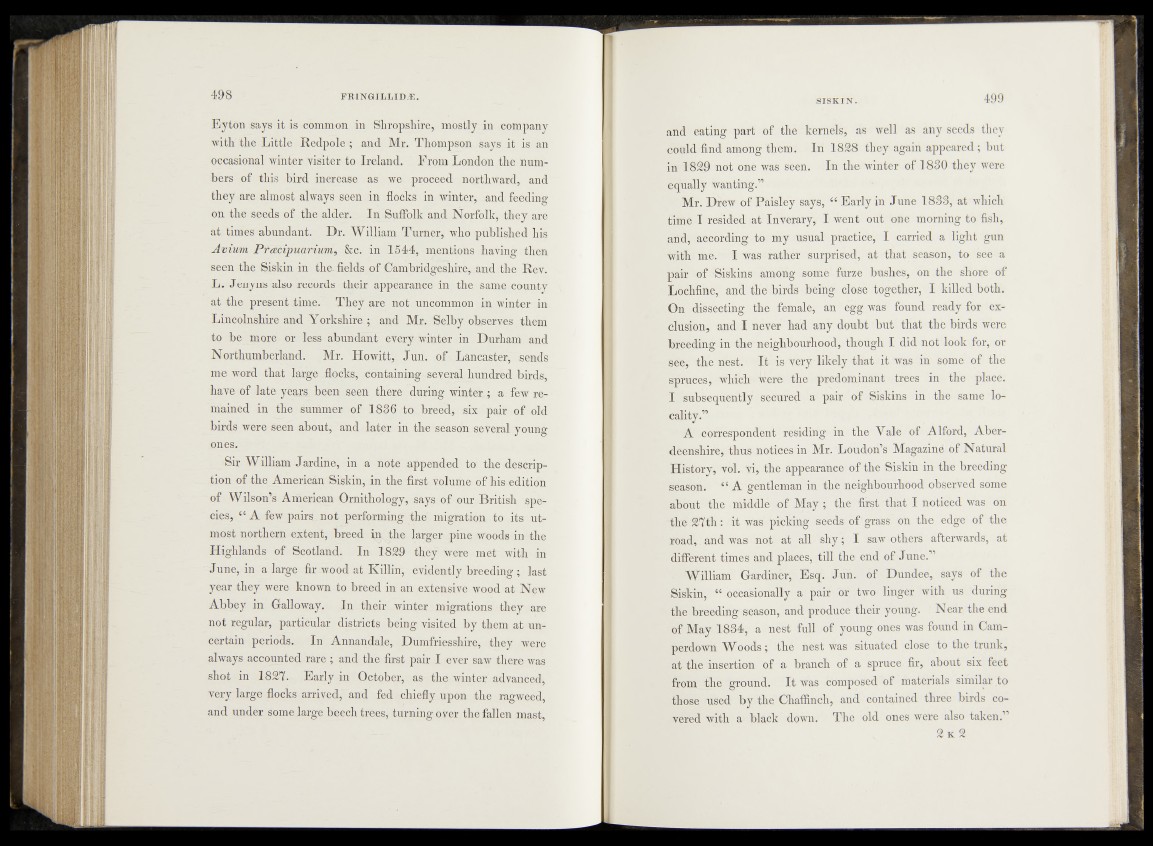
Eyton says it is common in Shropshire, mostly in company
with the Little Redpole ; and Mr. Thompson says it is an
occasional winter visiter to Ireland. From London the numbers
of this bird increase as we proceed northward, and
they are almost always seen in flocks in winter, and feeding
on the seeds of the alder. In Suffolk and Norfolk, they are
at times abundant. Dr. William Turner, who published his
Avium Prcecipuarium, &c. in 1544, mentions having then
seen the Siskin in the. fields of Cambridgeshire, and the Rev.
L. Jenyns also records their appearance in the same county
at the present time. They are not uncommon in winter in
Lincolnshire and Yorkshire ; and Mr. Selby observes them
to be more or less abundant every winter in Durham and
Northumberland. Mr. Howitt, Jun. of Lancaster, sends
me word that large flocks, containing several hundred birds,
have of late years been seen there during winter; a few remained
in the summer of 1886 to breed, six pair of old
birds were seen about, and later in the season several young
ones.
Sir William Jardine, in a note appended to the description
of the American Siskin, in the first volume of his edition
of Wilson’s American Ornithology, says of our British species,
U A few pairs not performing the migration to its utmost
northern extent, breed in the larger pine woods in the
Highlands of Scotland. In 1829 they were met with in
June, in a large fir wood at Killin, evidently breeding ; last
year they were known to breed in an extensive wood at New
Abbey in Galloway. In their winter migrations they are
not regular, particular districts being visited by them at uncertain
periods. In Annandale, Dumfriesshire, they were
always accounted rare ; and the first pair I ever saw there was
shot in 1827. Early in October, as the winter advanced,
very large flocks arrived, and fed chiefly upon the ragweed,
and under some large beech trees, turning over the fallen mast,
and eating part of the kernels, as well as any seeds they
could find among them. In 1828 they again appeared; but
in 1829 not one was seen. In the winter of 1880 they were
equally wanting.”
Mr. Drew of Paisley says, “ Early in June 1838, at which
time I resided at Inverary, I went out one morning to fish,
and, according to my usual practice, I carried a light gun
with me. I was rather surprised, at that season, to see a
pair of Siskins among some furze bushes, on the shore of
Lochfine, and the birds being close together, I killed both.
On dissecting the female, an egg was found ready for exclusion,
and I never had any doubt but that the birds were
breeding in the neighbourhood, though I did not look for, or
see, the nest. It is very likely that it was in some of the
spruces, which were the predominant trees in the place.
I subsequently secured a pair of Siskins in the same locality.”
A correspondent residing in the Vale of Alford, Aberdeenshire,
thus notices in Mr. Loudon’s Magazine of Natural
History, vol. vi, the appearance of the Siskin in the breeding
season. “ A gentleman in the neighbourhood observed some
about the middle of May; the first that I noticed was on
the 27th: it was picking seeds of grass on the edge of the
road, and was not at all shy; I saw others afterwards, at
different times and places, till the end of J une.”
William Gardiner, Esq. Jun. of Dundee, says of the
Siskin, “ occasionally a pair or two linger with us during
the breeding season, and produce their young. Near the end
of May 1884, a nest full of young ones was found in Cam-
perdown W^oods; the nest was situated close to the trunk,
at the insertion of a branch of a spruce fir, about six feet
from the ground. I t was composed of materials similar to
those used by the Chaffinch, and contained three birds covered
with a black down. The old ones were also taken.”
2 k 2